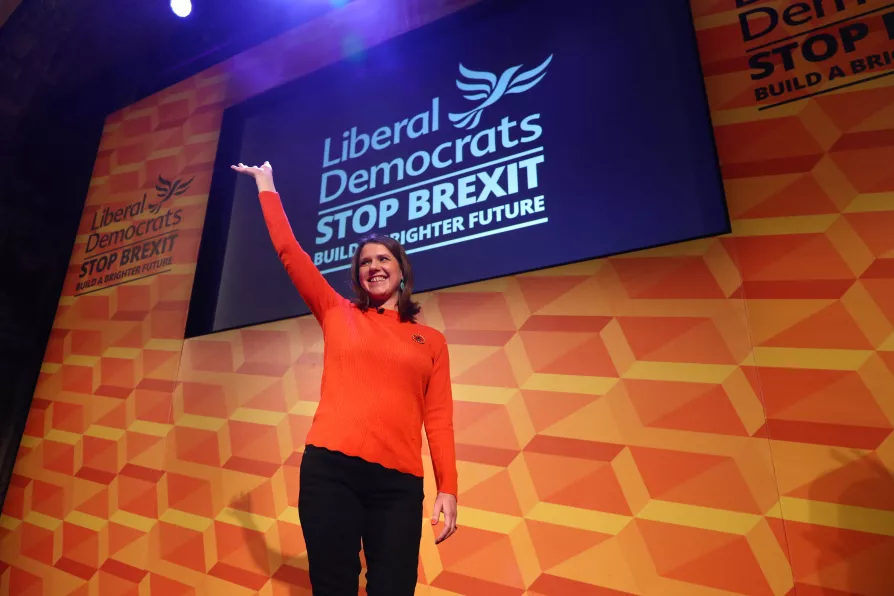Ten days after right-wing destabilisation attempts, Mexico’s leadership has emerged strengthened, securing historic labour and wage agreements, while opposition-backed protests have crumbled under scrutiny, says DAVID RABY

 Liberal Democrats leader Jo Swinson makes a speech at a rally at the Battersea Arts Centre in Lavender Hill
Liberal Democrats leader Jo Swinson makes a speech at a rally at the Battersea Arts Centre in Lavender Hill
TACTICAL voting is always part of elections, with many people following the old adage that it’s not who you vote for that counts, it’s who you vote against.
All parties seek to benefit from this, but some are taking it a step further for this election.
On Wednesday, the Lib Dems, Greens and Welsh nationalists Plaid Cymru unveiled a non-aggression pact covering 60 constituencies, each of which will see just one official “Unite to Remain” candidate from among the three parties.
The stated aim is to maximise the number of anti-Brexit MPs — but it could easily result in gains for the Tories instead, making a hard Brexit more likely.
To see why, look at the results of the last general election, two years ago. This is the starting point for any kind of tactical voting — not local or European elections, which have very different turnouts and voting patterns.
Most of the 60 listed seats — 38 — were won by the Tories, 13 by Labour and the remaining nine by one of the three so-called “Remain alliance” parties.
Take the last nine first. Obviously, if one — or two in Wales — of your potential rival Remain parties steps down in support of your candidacy, that increases your chances of re-election, which won’t affect the nationwide picture.
More interesting are the 51 other constituencies carved up by the alliance, the ones they want to win from the Tories or Labour.
But unfortunately for the insurgents, in each of these target seats their combined vote is less than that of the winning party — so, even if every vote transferred to the single candidate, it still wouldn’t be enough to take the seat.
This means they need some of Labour’s Remain vote to win, but in 35 of these 51 seats it’s a straight two-horse red-blue race — so any remainer drift from Labour can only help the Tories.
Look at these 35 Tory-Labour battlegrounds more closely and you can see how reckless this strategy really is.
In all but three of them, combining the entire alliance vote would still only deliver third place.
Put simply, they have absolutely no chance of winning here, but they could certainly split the anti-Tory vote.
Take Stroud, for example. Labour leftwinger David Drew took the seat back from the Tories two years ago, winning almost 30,000 votes, but has a majority of just 687.
Yet the Greens, despite placing fourth in 2017 with a measly 1,423 votes, are targeting this seat hard and have a high-profile MEP as candidate.
Even if they pick up each and every Lib Dem vote, it wouldn’t be nearly enough to win. What it could do, of course, is let the Tories back in by diverting vital votes away from Labour.
Of the 60 constituencies on the list, eight are marginals between Labour and the Tories with majorities of under 3,000 — that’s eight seats where the alliance have no chance but could easily split Labour’s vote and see a Tory elected instead.
And in all eight, the combined alliance vote is greater than the winner’s majority, meaning if they backed Labour there’d be a good chance of blocking the Tories.
But the Lib Dems won’t do this, because they’re far more interested in gaining a few extra MPs than stopping Brexit. That’s been clear since their shift from a second referendum to revoke.
In order to stop Brexit like this, they would need a clear majority in the Commons — at least 326 seats — with support from Plaid, the Greens and possibly the SNP, who between them could muster an absolute maximum of 76.
That would leave another 250 that the Lib Dems would have to win themselves. Even at the height of “Cleggmania” in 2010, they only reached 57 seats — plunging to eight in 2015 as voters punished them for propping up the Tories in a coalition.
Two years later, this had risen to 12 — with the party coming second in 37 other seats, making a total of just 49 in which they could be called “competitive.”
This non-aggression pact is a pretty good deal for the Lib Dems. In exchange for standing aside in 17 seats where they are nowhere, their Remain rivals are giving them practically a clear run everywhere else, because neither the Greens or Plaid are going to put much effort into electing candidates in other constituencies
But, despite their leader’s delusions of grandeur, there’s simply no way the Lib Dems can form a government next month. Bookies are offering around 50/1 against them even being the largest party.
And by conning voters into believing they can cancel Brexit, they again risk splitting the crucial Remain vote.
Conning voters is what Lib Dems do best. And for this election, they’re taking their notoriously misleading graphs to a whole new level.
Recent material aimed at North East Somerset voters featured a dramatic bar chart showing the Tories on 38 per cent, Lib Dems on 32 and Labour on 8. The message was explicit; vote Lib Dem if you want to beat the incumbent, Jacob Rees-Mogg.
Compared with the last general election, Labour and the Lib Dems seem to have switched places. Back in 2017, the Tories won with 54 per cent, Labour were on 35 and it was the Lib Dems in third with 8. What could account for such a dramatic turnaround?
Well, the tiny text under the graph explains that this actually represented an opinion poll, in which the question asked was: “Imagine that the result in your constituency was expected to be very close between the Conservatives and Liberal Democrat candidate, and none of the other parties were competitive. In this scenario, which party would you vote for?”
Intentionally misleading mathematics? It would seem so.
In Putney, a Lib Dem leaflet claimed “YouGov polling” put them neck and neck with the Tories on 31 per cent, while Labour languished behind on 18.
In reality, the Tories won the seat by just 1,554 votes more than Labour in 2017, with the Lib Dems in third place on 5,448 or 12 per cent.
The fake figures came from blogging website Flavible, which is not a member of the British Polling Council. Last week, Flavible accused the Lib Dems of “intentionally misinforming” voters.
The party has used Flavible figures on leaflets in other seats including Esher & Walton, Enfield Southgate, Islington North, Oxford East and Westminster & City, Woking and York Outer.

With ‘Your Party’ holding its founding conference in Liverpool this weekend, JEREMY CORBYN speaks to Morning Star editor Ben Chacko about its potential, its priorities — and a few of its controversies too

Every Starmer boast about removing asylum-seekers probably wins Reform another seat while Labour loses more voters to Lib Dems, Greens and nationalists than to the far right — the disaster facing Labour is the leadership’s fault, writes DIANE ABBOTT MP

While Reform poses as a workers’ party, a credible left alternative rooted in working-class communities would expose their sham — and Corbyn’s stature will be crucial to its appeal, argues CHELLEY RYAN











